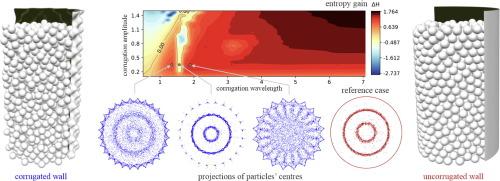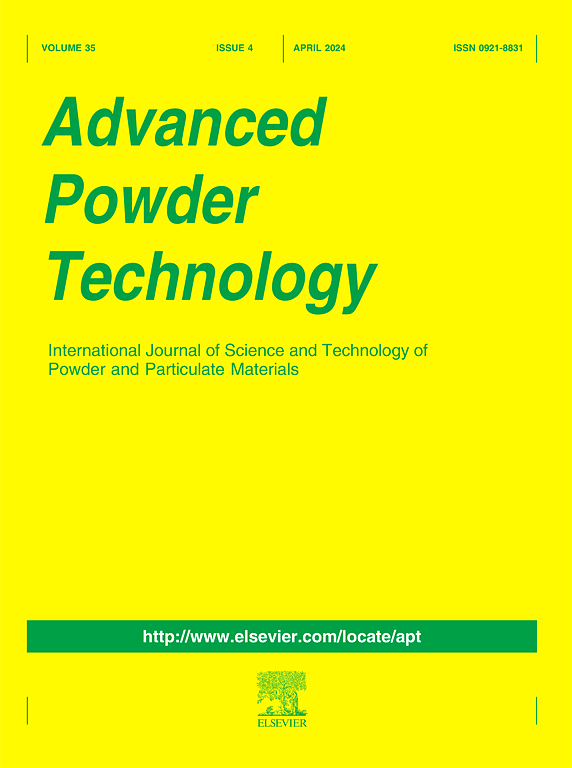Preventing near-wall particles’ ordering in narrow random packed beds of spheres
IF 4.2
2区 工程技术
Q2 ENGINEERING, CHEMICAL
引用次数: 0
Abstract
Packed-bed reactors with small container-to-particle diameter ratios () face significant performance challenges due to wall-induced flow maldistribution. The characteristic oscillatory void fraction pattern near container’s wall creates preferential flow paths that compromise reaction uniformity and transport efficiency. While modifications of the container’s wall structure have emerged as a potential solution to this problem, the relationship between the length scales of the modifications and packing homogeneity remains insufficiently explored. This study employs numerical modelling to investigate systematically how regular sinusoidal wall corrugation pattern influences particle arrangement and void fraction distribution in randomly packed beds of spherical particles in relatively narrow beds (). In a wide parametric study with respect to the amplitude and wavelength of the corrugation, we demonstrate that properly tuned corrugation patterns can substantially suppress near-wall layering and reduce local void fraction oscillations, promoting more uniform and disordered bed structures. We also observe a geometric resonance phenomenon with respect to the corrugation wavelength near value equal to approximately where the sensitivity of the packing structure to this parameter is particularly pronounced. These findings provide practical design guidance for improving performance in small-scale random packed-bed systems.

防止近壁粒子在狭窄的球形随机堆积床中有序排列
容器与颗粒直径比较小(Dc/Dp≤10)的填料床反应器由于壁面引起的流动不均匀分布而面临显著的性能挑战。容器壁面附近的特征振荡空隙率模式产生了优先流动路径,损害了反应均匀性和运输效率。虽然对容器壁结构的修改已经成为解决这一问题的潜在方法,但修改长度尺度与包装均匀性之间的关系仍然没有得到充分的探讨。本文采用数值模拟的方法,系统地研究了在相对狭窄的层(4≤Dc/Dp≤10)中球形颗粒随机堆积层(4≤Dc/Dp≤10)中,规则的正弦壁面波纹模式对颗粒排列和空隙率分布的影响。在一项关于波纹振幅和波长的广泛参数研究中,我们证明了适当调谐的波纹模式可以显著抑制近壁分层,减少局部空隙率振荡,促进更均匀和无序的床层结构。我们还观察到一种几何共振现象,在波纹波长附近的值大约等于1.6Dp,其中填料结构对该参数的灵敏度特别明显。这些发现为提高小型随机填充床系统的性能提供了实用的设计指导。
本文章由计算机程序翻译,如有差异,请以英文原文为准。
求助全文
约1分钟内获得全文
求助全文
来源期刊

Advanced Powder Technology
工程技术-工程:化工
CiteScore
9.50
自引率
7.70%
发文量
424
审稿时长
55 days
期刊介绍:
The aim of Advanced Powder Technology is to meet the demand for an international journal that integrates all aspects of science and technology research on powder and particulate materials. The journal fulfills this purpose by publishing original research papers, rapid communications, reviews, and translated articles by prominent researchers worldwide.
The editorial work of Advanced Powder Technology, which was founded as the International Journal of the Society of Powder Technology, Japan, is now shared by distinguished board members, who operate in a unique framework designed to respond to the increasing global demand for articles on not only powder and particles, but also on various materials produced from them.
Advanced Powder Technology covers various areas, but a discussion of powder and particles is required in articles. Topics include: Production of powder and particulate materials in gases and liquids(nanoparticles, fine ceramics, pharmaceuticals, novel functional materials, etc.); Aerosol and colloidal processing; Powder and particle characterization; Dynamics and phenomena; Calculation and simulation (CFD, DEM, Monte Carlo method, population balance, etc.); Measurement and control of powder processes; Particle modification; Comminution; Powder handling and operations (storage, transport, granulation, separation, fluidization, etc.)
 求助内容:
求助内容: 应助结果提醒方式:
应助结果提醒方式:


